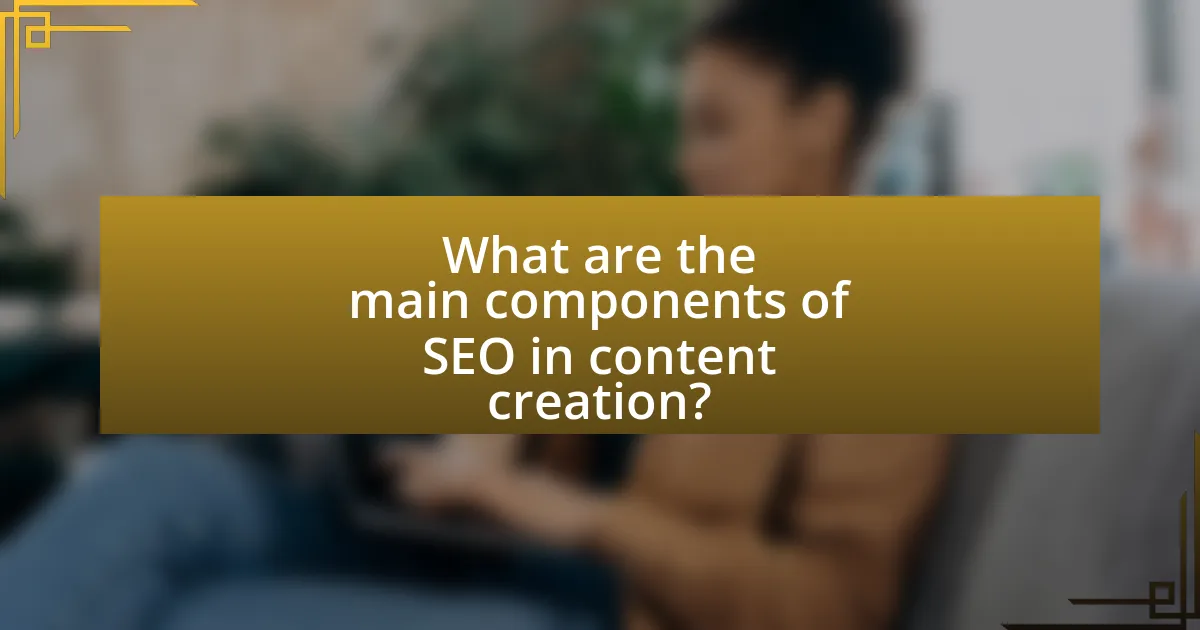The article focuses on the critical role of SEO in content creation for media platforms, emphasizing its importance in enhancing visibility and driving organic traffic. It outlines key SEO strategies, including keyword research, on-page optimization, and link building, which collectively improve content reach and user engagement. The article also discusses the consequences of neglecting SEO, the impact of effective practices on audience retention, and the tools available for optimizing content. Additionally, it addresses common challenges in applying SEO and offers best practices for integrating SEO into content strategies, ensuring that media platforms can effectively reach their target audiences.

What is the Role of SEO in Content Creation for Media Platforms?
SEO plays a crucial role in content creation for media platforms by enhancing visibility and driving organic traffic. By optimizing content with relevant keywords, media platforms can improve their search engine rankings, making it easier for users to discover their articles, videos, or podcasts. According to a study by HubSpot, 75% of users never scroll past the first page of search results, highlighting the importance of SEO in capturing audience attention. Additionally, effective SEO strategies, such as using meta tags and optimizing images, can significantly increase user engagement and retention on media platforms.
How does SEO influence content visibility on media platforms?
SEO significantly influences content visibility on media platforms by optimizing content for search engines, which enhances discoverability. When content is optimized with relevant keywords, meta tags, and quality backlinks, it ranks higher in search engine results, leading to increased traffic. For instance, a study by HubSpot found that 75% of users never scroll past the first page of search results, highlighting the importance of SEO in ensuring content appears prominently. Additionally, effective SEO practices improve user engagement metrics, such as click-through rates and time spent on page, further boosting visibility on platforms like Google and social media.
What are the key SEO strategies for enhancing content reach?
Key SEO strategies for enhancing content reach include optimizing for relevant keywords, improving site speed, and building quality backlinks. Optimizing for relevant keywords involves conducting thorough keyword research to identify terms that potential audiences are searching for, which can increase visibility in search engine results. Improving site speed is crucial, as studies show that a one-second delay in page load time can lead to a 7% reduction in conversions. Building quality backlinks from reputable sites enhances domain authority, which search engines consider when ranking content. According to a study by Moz, backlinks are one of the top three ranking factors in Google’s algorithm, underscoring their importance in enhancing content reach.
How does keyword research impact content creation?
Keyword research significantly impacts content creation by guiding the development of relevant and targeted material that aligns with user search intent. By identifying popular and relevant keywords, content creators can tailor their topics, headlines, and overall messaging to meet the needs of their audience. This alignment increases the likelihood of higher search engine rankings and improved visibility. For instance, a study by Ahrefs found that pages optimized for specific keywords can achieve up to 1,000% more organic traffic compared to those that are not. Therefore, effective keyword research not only informs content strategy but also enhances engagement and reach.
Why is SEO important for media platforms?
SEO is important for media platforms because it enhances visibility and drives organic traffic to their content. By optimizing content for search engines, media platforms can improve their rankings on search engine results pages, making it easier for users to discover their articles, videos, and other media. According to a study by HubSpot, 75% of users never scroll past the first page of search results, highlighting the necessity for media platforms to implement effective SEO strategies to reach their target audience. Additionally, SEO helps in building credibility and authority, as higher-ranking content is often perceived as more trustworthy by users.
What are the consequences of neglecting SEO in content creation?
Neglecting SEO in content creation leads to reduced visibility and lower organic traffic. Without proper SEO practices, content may not rank well on search engines, resulting in fewer users discovering the material. According to a study by HubSpot, 75% of users never scroll past the first page of search results, highlighting the importance of ranking. Additionally, poor SEO can lead to a lack of engagement and higher bounce rates, as users may not find the content relevant to their queries. This ultimately affects brand credibility and can result in lost revenue opportunities, as businesses miss out on potential customers searching for related information.
How does SEO contribute to audience engagement and retention?
SEO enhances audience engagement and retention by improving content visibility and relevance in search results. When websites optimize their content for search engines, they attract more organic traffic, which increases the likelihood of user interaction. According to a study by HubSpot, 75% of users never scroll past the first page of search results, indicating that higher rankings lead to more clicks and engagement. Furthermore, SEO practices such as keyword optimization and quality backlinks ensure that the content meets user intent, fostering a better user experience. This alignment between content and audience needs not only keeps users on the site longer but also encourages repeat visits, thereby enhancing retention.

What are the main components of SEO in content creation?
The main components of SEO in content creation are keyword research, on-page optimization, content quality, and link building. Keyword research involves identifying relevant terms and phrases that potential audiences use to search for content, ensuring that the content aligns with user intent. On-page optimization includes optimizing title tags, meta descriptions, headers, and images to enhance search engine visibility. Content quality focuses on creating valuable, engaging, and informative content that meets the needs of the audience, which is crucial for retaining visitors and reducing bounce rates. Link building refers to acquiring backlinks from reputable sources, which signals authority and improves search rankings. These components collectively enhance the discoverability and effectiveness of content on media platforms.
How do on-page SEO techniques enhance content quality?
On-page SEO techniques enhance content quality by optimizing various elements within a webpage to improve its relevance and user experience. These techniques include the use of targeted keywords, which help search engines understand the content’s focus, thereby increasing its visibility in search results. Additionally, proper formatting, such as using headings and bullet points, improves readability, making it easier for users to digest information.
Furthermore, optimizing meta tags, such as title tags and meta descriptions, ensures that content is accurately represented in search results, attracting more clicks. Research indicates that pages with well-structured content and relevant keywords can achieve higher rankings, leading to increased organic traffic. For instance, a study by Backlinko found that the first result on Google has an average click-through rate of 31.7%, highlighting the importance of effective on-page SEO in driving engagement and enhancing content quality.
What role do meta tags play in content optimization?
Meta tags play a crucial role in content optimization by providing search engines with essential information about a webpage’s content. These HTML elements, such as title tags and meta descriptions, help improve visibility in search engine results pages (SERPs) by influencing click-through rates and search rankings. For instance, a well-crafted title tag can increase the likelihood of users clicking on a link, as it summarizes the page’s content effectively. According to a study by Moz, approximately 70% of search engine users are more likely to click on a result with a compelling title tag. Thus, meta tags are vital for enhancing both user engagement and search engine performance.
How can internal linking improve SEO performance?
Internal linking improves SEO performance by enhancing site navigation and distributing page authority across a website. When a website employs internal links, it allows search engines to crawl the site more effectively, leading to better indexing of pages. This practice also helps users discover related content, increasing engagement and reducing bounce rates. According to a study by Moz, internal links can significantly influence search rankings, as they help establish a hierarchy of information and signal to search engines which pages are most important.
What off-page SEO strategies should be considered?
Off-page SEO strategies that should be considered include link building, social media engagement, and influencer outreach. Link building enhances a website’s authority by acquiring backlinks from reputable sources, which can improve search engine rankings; for instance, websites with a higher number of quality backlinks tend to rank better in search results. Social media engagement increases brand visibility and drives traffic to the website, as platforms like Facebook and Twitter can amplify content reach and foster community interaction. Influencer outreach involves collaborating with industry leaders to promote content, leveraging their audience to gain credibility and expand reach, which has been shown to significantly impact brand awareness and referral traffic.
How does backlinking affect content authority?
Backlinking significantly enhances content authority by signaling to search engines that the content is credible and valuable. When reputable websites link to a piece of content, it indicates that the content is trustworthy and relevant, which can improve its ranking in search engine results. Studies show that pages with a higher number of quality backlinks tend to rank better; for instance, a study by Ahrefs found that 91% of content never gets any organic traffic, primarily due to a lack of backlinks. Therefore, effective backlinking strategies can directly influence a website’s perceived authority and visibility in search results.
What are the best practices for social media integration in SEO?
The best practices for social media integration in SEO include optimizing social media profiles, sharing high-quality content, and encouraging user engagement. Optimizing social media profiles involves using relevant keywords in bios and descriptions, which can enhance visibility in search results. Sharing high-quality content that is valuable and relevant to the audience increases the likelihood of shares and backlinks, both of which positively impact SEO. Encouraging user engagement through comments, shares, and likes can drive traffic to the website and improve search rankings, as social signals are increasingly recognized by search engines as indicators of content quality.

How can media platforms effectively implement SEO in their content strategy?
Media platforms can effectively implement SEO in their content strategy by optimizing their content for relevant keywords, ensuring high-quality backlinks, and enhancing user experience. By conducting thorough keyword research, platforms can identify terms that their target audience frequently searches for, allowing them to create content that meets those needs. Additionally, acquiring backlinks from reputable sites boosts domain authority, which is crucial for ranking higher in search engine results. Furthermore, improving user experience through fast loading times, mobile optimization, and intuitive navigation keeps visitors engaged, reducing bounce rates and signaling to search engines that the content is valuable. According to a study by Moz, websites with higher domain authority tend to rank better, reinforcing the importance of backlinks in SEO strategy.
What tools are available for optimizing content for SEO?
Several tools are available for optimizing content for SEO, including Google Analytics, SEMrush, Ahrefs, Moz, and Yoast SEO. Google Analytics provides insights into website traffic and user behavior, helping to identify which content performs best. SEMrush and Ahrefs offer keyword research, backlink analysis, and site audits, enabling users to enhance their SEO strategies effectively. Moz provides tools for tracking keyword rankings and optimizing on-page elements, while Yoast SEO is a popular plugin for WordPress that assists in optimizing content for readability and keyword usage. These tools are widely recognized in the industry for their effectiveness in improving search engine visibility and driving organic traffic.
How can analytics be used to refine SEO strategies?
Analytics can be used to refine SEO strategies by providing data-driven insights into user behavior, keyword performance, and content effectiveness. By analyzing metrics such as organic traffic, bounce rates, and conversion rates, marketers can identify which keywords drive the most traffic and which pages have high engagement. For instance, Google Analytics reports that websites with optimized content can see a 14.6% conversion rate compared to 1.7% for outbound leads, highlighting the importance of targeted SEO efforts. Additionally, tools like Google Search Console allow for tracking keyword rankings and click-through rates, enabling adjustments to content and meta tags to improve visibility. This data-driven approach ensures that SEO strategies are continuously optimized based on real user interactions and search trends.
What role does A/B testing play in content optimization?
A/B testing plays a crucial role in content optimization by allowing marketers to compare two versions of content to determine which performs better in achieving specific goals, such as higher engagement or conversion rates. This method provides data-driven insights that inform content strategies, enabling the selection of the most effective elements, such as headlines, images, or calls to action. For instance, a study by Optimizely found that A/B testing can lead to conversion rate improvements of up to 49%, demonstrating its effectiveness in optimizing content for better performance.
What are the common challenges in applying SEO to content creation?
Common challenges in applying SEO to content creation include keyword research difficulties, content optimization issues, and maintaining content quality while adhering to SEO guidelines. Keyword research can be complex due to the need to balance search volume with relevance, making it hard to identify the best terms to target. Content optimization often requires a deep understanding of SEO best practices, which can lead to inconsistencies in implementation. Additionally, creators may struggle to produce high-quality, engaging content that also meets SEO requirements, as prioritizing one can compromise the other. These challenges are supported by studies indicating that 61% of marketers consider generating traffic and leads as their top challenge, highlighting the importance of effective SEO strategies in content creation.
How can content creators overcome SEO-related obstacles?
Content creators can overcome SEO-related obstacles by implementing effective keyword research, optimizing on-page elements, and enhancing content quality. Conducting thorough keyword research allows creators to identify relevant terms that their target audience is searching for, which can significantly improve visibility. Optimizing on-page elements, such as title tags, meta descriptions, and header tags, ensures that search engines can easily understand the content’s relevance. Additionally, focusing on high-quality, engaging content that provides value to users can lead to better user engagement and lower bounce rates, both of which positively impact SEO rankings. According to a study by HubSpot, companies that prioritize blogging are 13 times more likely to achieve a positive ROI, highlighting the importance of quality content in overcoming SEO challenges.
What are the pitfalls to avoid in SEO content strategy?
The main pitfalls to avoid in SEO content strategy include keyword stuffing, neglecting user intent, and failing to optimize for mobile. Keyword stuffing, which involves overusing keywords in an attempt to manipulate search rankings, can lead to penalties from search engines, as evidenced by Google’s algorithms that prioritize quality content over keyword density. Neglecting user intent results in content that does not meet the needs or expectations of the audience, ultimately decreasing engagement and increasing bounce rates. Additionally, failing to optimize for mobile can alienate a significant portion of users, as mobile devices account for over 50% of global web traffic, according to Statista. These pitfalls can severely hinder the effectiveness of an SEO content strategy.
What are the best practices for integrating SEO into content creation?
The best practices for integrating SEO into content creation include conducting keyword research, optimizing on-page elements, creating high-quality content, and ensuring mobile-friendliness. Keyword research identifies relevant terms that potential readers search for, guiding content topics and structure. Optimizing on-page elements, such as title tags, meta descriptions, and headers, enhances visibility in search engine results. High-quality content that provides value and engages users leads to longer dwell times and lower bounce rates, which positively impacts SEO rankings. Additionally, ensuring that content is mobile-friendly is crucial, as over 50% of global web traffic comes from mobile devices, according to Statista. These practices collectively improve search engine visibility and user experience.
How can content creators stay updated with SEO trends?
Content creators can stay updated with SEO trends by regularly following reputable SEO blogs, attending industry webinars, and participating in online forums. Reputable sources such as Moz, Search Engine Journal, and Neil Patel’s blog provide insights into the latest algorithm changes and best practices. Additionally, attending webinars hosted by SEO experts allows creators to gain firsthand knowledge of emerging trends. Engaging in online communities, such as those on Reddit or LinkedIn, facilitates discussions with peers and industry leaders, further enhancing understanding of current SEO dynamics.
What tips can enhance the effectiveness of SEO in media content?
To enhance the effectiveness of SEO in media content, focus on optimizing metadata, using relevant keywords, and ensuring mobile-friendliness. Optimizing metadata, including title tags and descriptions, improves search engine visibility and click-through rates. Research indicates that 70% of users are more likely to click on a well-optimized title. Incorporating relevant keywords naturally within the content increases the likelihood of ranking higher in search results; studies show that pages with targeted keywords see a 50% increase in organic traffic. Additionally, ensuring that media content is mobile-friendly is crucial, as over 50% of global web traffic comes from mobile devices, according to Statista.

Leave a Reply